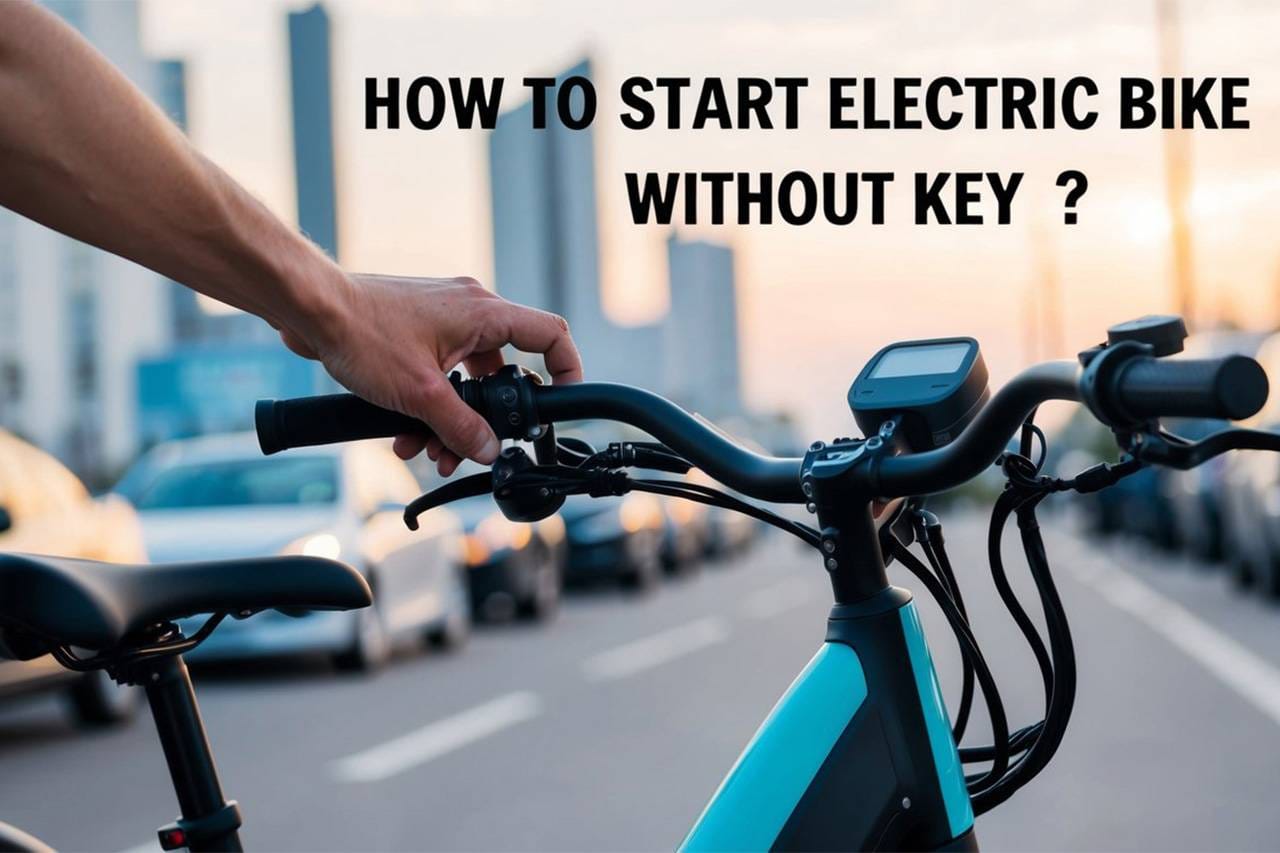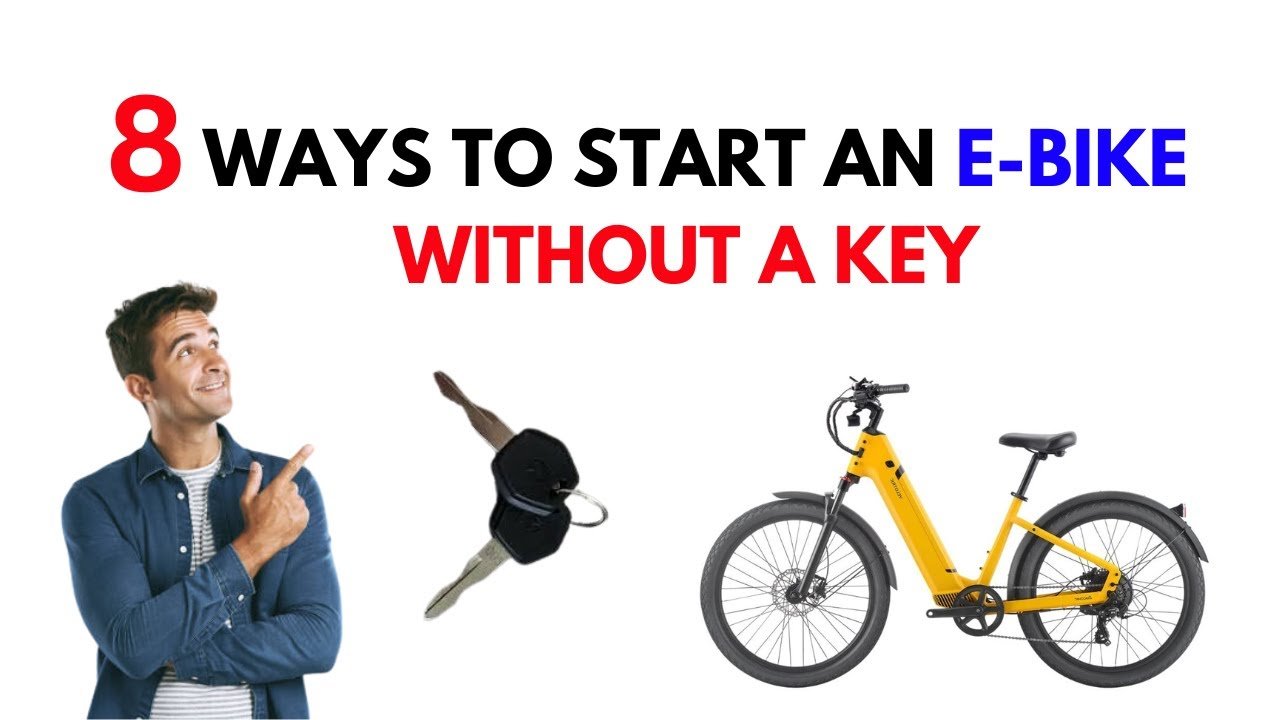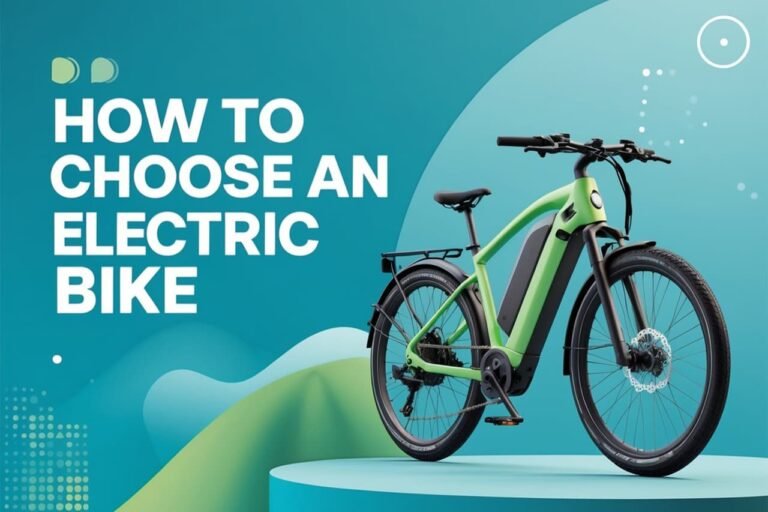
Finding yourself stranded with a dead electric bike battery or lost key can turn a great day into a frustrating experience. Many e-bike owners wonder if there’s a way to get their ride moving again without the original key.
Most electric bikes can be started without a key by bypassing the ignition system through wire connections, using the controller directly, or removing the battery lock mechanism. The specific method depends on the bike’s design, but these approaches typically involve accessing the main wiring harness or controller unit to create a direct power connection.
This guide covers the essential tools needed, step-by-step methods for different e-bike types, and safety precautions to keep in mind. You’ll also learn how to handle battery locks and prevent future key problems with your electric bike.
Can You Start an Electric Bike Without the Key?
Yes, most electric bikes can be started without their original key, though the methods vary by bike type and security system. The process involves understanding your specific e-bike’s ignition system and using appropriate bypass techniques.
Understanding E-Bike Ignition Systems
Electric bikes use different types of ignition systems that control power flow from the battery to the motor. The most common system is a simple key switch that completes an electrical circuit when turned.
Basic key switches work like a toggle – they either allow or block power from reaching the bike’s controller. When someone turns the e-bike key, it closes the circuit and enables the motor.
Smart key systems are more complex and use coded signals between the key and bike. These systems send specific electronic codes that must match before the bike will start.
Display-based systems combine the key function with the bike’s LCD screen. The rider needs both the key and must activate the display to start riding.
Here are the main e-bike ignition types:
- Toggle key switch – Simple on/off mechanism
- Coded key fob – Sends electronic signals
- Integrated display – Key plus screen activation
- App-based – Smartphone unlocking system
When You Might Need to Start Without the Key
Lost keys are the most common reason people need to start their electric bike without the original key. Many riders keep only one key and don’t realize they need a backup until it’s too late.
Emergency situations like medical appointments or work commitments make waiting for a replacement key impossible. A broken key stuck in the ignition also creates an immediate problem that needs solving.
Dead key fob batteries can leave riders stranded when their electronic keys stop working. This happens more often in cold weather when batteries drain faster.
Faulty ignition switches sometimes fail even with the correct key. The switch mechanism can wear out or get damaged from weather exposure.
Common scenarios include:
- Key lost during a ride
- Key broken off in ignition
- Electronic fob battery died
- Ignition switch malfunction
- Spare key needed immediately
Legal and Safety Considerations
Starting an electric bike without a key is legal when it’s your own bike, but riders should carry proof of ownership. Police officers might question someone working on bike electrical systems in public areas.
Theft concerns make this knowledge sensitive – the same techniques that help legitimate owners can be misused by thieves. Responsible riders should only use these methods on their own e-bikes.
Warranty issues can arise from modifying ignition systems or bypassing security features. Some manufacturers void coverage if they detect unauthorized electrical work.
Insurance problems might occur if a stolen bike was recovered using bypass methods. Documentation proving ownership becomes critical in these situations.
Safety risks include:
- Electrical shock from exposed wires
- Fire hazard from improper connections
- Motor damage from incorrect bypassing
- Legal trouble without ownership proof
Essential Tools and Precautions
Starting an electric bike without a key requires specific tools and safety measures to protect both the rider and the e-bike’s electrical system. Proper preparation prevents damage and ensures a safe bypass process.
Safety Gear and Equipment Needed
Personal protective equipment is crucial when working with electric bike systems. The rider should wear insulated gloves to prevent electrical shock from the battery or wiring. Safety glasses protect eyes from sparks or debris during the bypass process.
Essential tools include:
- Screwdriver set (flathead and Phillips head)
- Wire strippers for accessing ignition wires
- Electrical tape to secure connections
- Multimeter to test voltage safely
- Flashlight or headlamp for better visibility
Battery safety requires extra attention. Most e-bikes use lithium-ion batteries that can be dangerous if mishandled. The rider should never puncture or short-circuit the battery connections.
A well-ventilated workspace prevents buildup of any gases. Working outdoors or in a garage with open doors provides adequate airflow during the process.
Assessing Your E-Bike Model and Setup
Different e-bike models have varying ignition systems. Hub motor bikes typically have simpler wiring than mid-drive systems. The rider needs to identify their specific model before attempting any bypass.
Key components to locate:
- Battery connection points
- Display unit wiring
- Controller housing
- Ignition switch location
Popular brands like Rad Power Bikes and Ancheer have online manuals showing wiring diagrams. These resources help riders understand their specific setup before starting work.
Some newer e-bikes have advanced security features like app-based locks or GPS tracking. These systems may require different approaches than traditional key ignitions. The rider should check if their bike has smart features that complicate the bypass process.
Step-by-Step Methods to Start Your E-Bike Without a Key
These methods range from simple checks for backup keys to more technical approaches like working with ignition wires. Each technique requires different tools and skill levels.
Checking for a Hidden or Spare Key
Many e-bike owners forget about spare keys attached to their bikes. Check under the seat, inside the battery compartment, or taped to the frame.
Some manufacturers hide backup keys in small magnetic boxes. These boxes stick to metal parts of the bike frame. Look around the motor housing and rear wheel area.
Common hiding spots include:
- Under the seat cushion
- Inside battery compartments
- Taped to the underside of the frame
- In small toolkits attached to the bike
The owner’s manual might mention spare key locations. Check any documentation that came with the e-bike. This simple step saves time and avoids damage to the bike’s electrical system.
Hotwiring: Bridging the Ignition Wires
This method works by connecting the right ignition wires together. Remove the plastic cover around the ignition switch area first.
Look for two thick wires coming from the ignition switch. These wires control the power flow to the motor. Strip about half an inch of insulation from each wire end.
Touch the bare wire ends together to complete the circuit. The bike should power on like it would with a key. Hold the wires together while riding or tape them securely.
Warning: This method can damage the electrical system if done wrong. Only try this on bikes you own. Some newer e-bikes have anti-theft systems that make hotwiring impossible.
Using a Screwdriver or Plastic Pen
A flat-head screwdriver can sometimes turn the ignition switch without a key. Insert the screwdriver into the keyhole and turn it gently.
Try different angles and pressure levels. Some ignition switches have loose tolerances that allow this method to work. A plastic pen with a flat tip also works for this technique.
Steps to follow:
- Insert tool into keyhole
- Apply gentle pressure while turning
- Try clockwise and counterclockwise directions
- Wiggle the tool if it gets stuck
This method works best on older e-bikes with worn ignition switches. Newer bikes have tighter security features that prevent this approach from working.
Applying a Shim or Bump Key
A shim is a thin piece of metal that slides between the key pins inside the lock. Cut a small piece from an aluminum can to create a basic shim.
Insert the shim into the top of the keyhole while turning the ignition switch. The shim pushes the pins out of the way. This allows the switch to turn without the proper e-bike key.
A bump key is a special key cut to work on multiple locks. These keys require specific techniques to use properly. Tap the bump key while applying turning pressure to the ignition switch.
Both methods take practice to master. They work better on simpler lock designs found in budget e-bikes.
Working Around the Battery Lock
Some e-bikes have battery locks that prevent the bike from starting. These locks can be bypassed manually or by removing the battery completely.
Manually Releasing the Battery Lock
Most electric bikes have a physical release mechanism near the battery compartment. Look for a small lever, button, or sliding tab underneath or beside the battery pack.
Press or slide this mechanism while gently pulling the battery upward. The battery should lift out of its mounting bracket when the lock disengages properly.
Common battery lock locations:
- Under the battery pack near the frame
- Side-mounted release buttons
- Twist-lock mechanisms at the base
- Spring-loaded tabs on battery rails
If the release feels stuck, check for dirt or debris around the locking mechanism. Clean the area with a dry cloth before trying again.
Removing the Battery for Manual Use
Once the battery comes free from the frame, riders can still use their e-bike. The battery connects to the motor system through a detachable cable or port.
Find the main power connector between the battery and bike frame. This usually looks like a thick cable with a plastic connector end.
Reconnect the battery by plugging it back into the motor system. The battery doesn’t need to sit in its original mounting position to power the bike.
Secure the loose battery in a backpack or bike basket during rides. Make sure the power cable has enough length to reach without pulling tight.
Battery Tricks for Integrated Locks
Some newer e-bikes have batteries built directly into the frame with electronic locks. These systems often have backup power sources that keep the lock active.
Look for a small backup battery compartment near the main battery housing. Remove this backup battery to reset the electronic lock system.
Wait 10-15 minutes after removing the backup power. This allows the lock’s memory to clear completely before attempting to start the bike.
Press and hold any power buttons on the battery for 30 seconds. This drains remaining power from the lock’s internal circuits and may reset the system.
After Getting Your E-Bike Started
Once someone successfully starts their electric bike without the original key, they need to address the security gap and prevent future lockouts. Getting a replacement key, finding professional help, or upgrading the lock system are the main steps to consider.
Ordering a Replacement E-Bike Key
Most e-bike manufacturers can provide replacement keys if the owner has the right information. They’ll need the bike’s serial number, model information, and proof of purchase.
The serial number is usually located on the frame near the bottom bracket or on a sticker under the battery. Some manufacturers also put it on the original paperwork or warranty card.
Key replacement requirements typically include:
- Original purchase receipt or warranty registration
- Photo ID matching the purchaser’s name
- Bike serial number and model year
- Lock cylinder number (if visible on the key slot)
Replacement keys usually cost $15-50 depending on the manufacturer. Popular brands like Rad Power Bikes and Trek often ship replacements within 7-10 business days.
Some manufacturers require the bike to be brought to an authorized dealer for key programming, especially for newer models with electronic security systems.
When to Call a Locksmith or Dealer
A professional locksmith can help when manufacturer replacement isn’t possible or takes too long. However, not all locksmiths work on e-bike locks since they use specialized cylinders.
Motorcycle locksmiths usually have better success with e-bike keys than regular residential locksmiths. They’re familiar with similar locking mechanisms and security features.
Call a professional when:
- The manufacturer no longer makes replacement keys
- Proof of purchase is lost or unavailable
- The lock cylinder is damaged from previous attempts
- Multiple keys are needed quickly
Locksmith services typically cost $75-150 for e-bike key replacement. Some can create new keys on-site, while others need to remove the lock cylinder.
Authorized dealers can also reprogram electronic locks and provide genuine replacement parts. They’re the best option for warranty-covered repairs.
Replacing or Upgrading Your Lock
Sometimes replacing the entire lock system makes more sense than getting new keys. This is especially true for older bikes or damaged locks.
Aftermarket e-bike locks range from $20 basic key switches to $100+ smart locks with phone connectivity. The new lock must match the original’s mounting holes and wire connections.
Popular upgrade options include:
- Keyed-alike systems – Multiple locks use the same key
- Smart locks – Phone app control with backup keys
- Heavy-duty cylinders – Better theft protection
- Weatherproof models – Extended outdoor durability
Most riders can install basic replacement locks with simple tools. However, smart locks or integrated security systems usually require professional installation to avoid damaging the bike’s electrical system.
Always disconnect the battery before working on any e-bike electrical components to prevent short circuits or injury.
Preventing Future Key Mishaps

Modern technology offers several solutions to avoid getting locked out of an e-bike again. Smart alternatives and proper key management can save riders from future headaches.
Smart Locks, Apps, and Keyless Options
Many newer electric bikes come with smartphone app integration that eliminates the need for physical keys entirely. These apps connect to the e-bike via Bluetooth and allow riders to start their bike with just a tap on their phone screen.
Fingerprint locks are becoming popular on premium e-bikes. The rider simply scans their finger to unlock and start the electric bike without key requirements.
Some manufacturers offer PIN code systems where riders enter a 4-6 digit code on a small keypad. This backup option works even when the main e-bike key gets lost.
Key replacement options vary by brand:
- Rad Power Bikes: $25 replacement key with proof of purchase
- Aventon: $15-30 depending on model
- Trek: $20-40 through authorized dealers
Third-party universal e-bike locks with app control can replace factory systems. These typically cost $80-150 but work across multiple bike brands.
Tips for Safe Key Storage and Duplication
Getting duplicate keys made before losing the original saves time and stress. Most e-bike keys can be copied at hardware stores for $3-8 per key.
Key storage best practices include:
- Keep one spare key at home in a designated spot
- Give a backup key to a trusted family member
- Use a small magnetic key holder under the bike seat
- Attach keys to a bright, hard-to-lose keychain
Never leave the e-bike key in the bike overnight or in public areas. Thieves often look for this easy target.
Consider a key tracking device like an AirTag or Tile for frequent key losers. These $25-30 devices help locate missing keys through smartphone apps.
Final Thoughts
Starting an electric bike without a key isn’t impossible, but it comes with real risks. Riders who find themselves locked out have several options to explore.
The bypass methods we covered can work in emergencies. However, they might void warranties or cause electrical damage. Smart riders always weigh these risks before attempting any workaround.
Key takeaways for keyless e-bike starting:
- Contact method works best – Touching specific wires together offers the highest success rate
- Tools matter – Having basic tools like screwdrivers and wire strippers helps tremendously
- Safety first – Always disconnect the battery before attempting any electrical work
- Legal concerns – Only try these methods on bikes you actually own
Prevention beats emergency fixes every time. Getting spare keys made costs far less than potential repair bills. Many bike shops can duplicate e-bike keys for under $20.
Some newer e-bike models use app-based locks instead of traditional keys. These smart systems eliminate the key problem entirely. Riders can unlock their bikes using smartphones or backup codes.
Remember that tampering with e-bike electrical systems can be dangerous. High-voltage batteries pack serious power. When in doubt, calling a professional bike mechanic saves time and prevents injuries.
The methods discussed here should only be last resorts for legitimate owners facing genuine emergencies.











